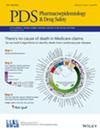监管干预对西班牙醋酸乌利司他 5 毫克(Esmya)使用的影响:间断时间序列分析
IF 2.4
4区 医学
Q3 PHARMACOLOGY & PHARMACY
引用次数: 0
摘要
目的自2017年底以来,由于新出现的肝脏风险,欧盟一直在对醋酸乌利司他5毫克(UPA;专有名称:Esmya)的使用进行审查。2018 年 2 月和 2018 年 7 月,西班牙药品和医疗器械管理局以及上市许可持有人实施了两项风险最小化措施(RMM),以通报新的安全性信息并降低这一风险。本研究旨在通过对 2014 年至 2019 年间的间断时间序列(ITS)进行分析,评估 RMM 在西班牙的有效性。方法对 RMM 发布前后 UPA 的使用情况进行了两项准实验性 ITS 分析:(a)一项生态研究,使用药物消费数据库中的汇总数据;(b)一项研究,使用从电子临床记录中收集的初级医疗保健数据。结果监管干预措施与 DID(每 10 万居民每天配发的 DDD 数量)和发病率的即时显著下降水平相关。干预 12 个月后,DID 比预期低 70%。发病率为 59%。尽管 RMM 对 UPA 的使用产生了立竿见影的巨大影响,但最后一段的长期上升趋势可能受到了缺乏可比替代治疗方法的影响。应开展进一步研究,以确认观察到的增加趋势,并分析后续措施和更多数据。本文章由计算机程序翻译,如有差异,请以英文原文为准。
Impact of Regulatory Interventions on Ulipristal Acetate 5 mg (Esmya) Use in Spain: An Interrupted Time‐Series Analysis
PurposeSince late 2017, the use of ulipristal acetate 5 mg (UPA; Proprietary name: Esmya) has been under review in the European Union, due to an emerging hepatic risk. In February 2018 and in July 2018, the Spanish Agency of Medicines and Medical Devices and the marketing authorization holder put two risk minimization measures (RMM) in place, in order to inform about new safety information and to mitigate this risk. This study aims to assess RMM effectiveness in Spain, by performing an interrupted time‐series (ITS) analyses, between 2014 and 2019.MethodTwo quasi‐experimental ITS analyses to examine the use of UPA before and after the RMM release were performed: (a) an ecological study using aggregated data from a drug consumption database; and (b) a study using primary healthcare data gathered from electronic clinical records.ResultsRegulatory interventions were associated with an immediate and significant decrease level of DID (the number of DDD dispensed per 100 000 inhabitants and day) and incidence. The DID was 70% less than expected 12 months after the interventions. This value was 59% for the incidence. However, a change in the slope was not observed and the use started rising again in the last segment of the study period.ConclusionDespite RMM had an immediate strong impact on UPA use, the last segment upward trend in the long‐term might have been affected by the lack of comparable therapeutic alternatives. Further studies should be performed to confirm the increase trend observed and analyze subsequent measures and additional data.
求助全文
通过发布文献求助,成功后即可免费获取论文全文。
去求助
来源期刊
CiteScore
4.80
自引率
7.70%
发文量
173
审稿时长
3 months
期刊介绍:
The aim of Pharmacoepidemiology and Drug Safety is to provide an international forum for the communication and evaluation of data, methods and opinion in the discipline of pharmacoepidemiology. The Journal publishes peer-reviewed reports of original research, invited reviews and a variety of guest editorials and commentaries embracing scientific, medical, statistical, legal and economic aspects of pharmacoepidemiology and post-marketing surveillance of drug safety. Appropriate material in these categories may also be considered for publication as a Brief Report.
Particular areas of interest include:
design, analysis, results, and interpretation of studies looking at the benefit or safety of specific pharmaceuticals, biologics, or medical devices, including studies in pharmacovigilance, postmarketing surveillance, pharmacoeconomics, patient safety, molecular pharmacoepidemiology, or any other study within the broad field of pharmacoepidemiology;
comparative effectiveness research relating to pharmaceuticals, biologics, and medical devices. Comparative effectiveness research is the generation and synthesis of evidence that compares the benefits and harms of alternative methods to prevent, diagnose, treat, and monitor a clinical condition, as these methods are truly used in the real world;
methodologic contributions of relevance to pharmacoepidemiology, whether original contributions, reviews of existing methods, or tutorials for how to apply the methods of pharmacoepidemiology;
assessments of harm versus benefit in drug therapy;
patterns of drug utilization;
relationships between pharmacoepidemiology and the formulation and interpretation of regulatory guidelines;
evaluations of risk management plans and programmes relating to pharmaceuticals, biologics and medical devices.

 求助内容:
求助内容: 应助结果提醒方式:
应助结果提醒方式:


